Feed Formulation Reference for Different Animals
Feed formulation ensures balanced nutrition for different animals. Since digestion and nutrient needs vary by species, their requirements for energy, protein, and fiber differ. Here provides practical feed formulas for poultry, livestock, and fish based on these needs.
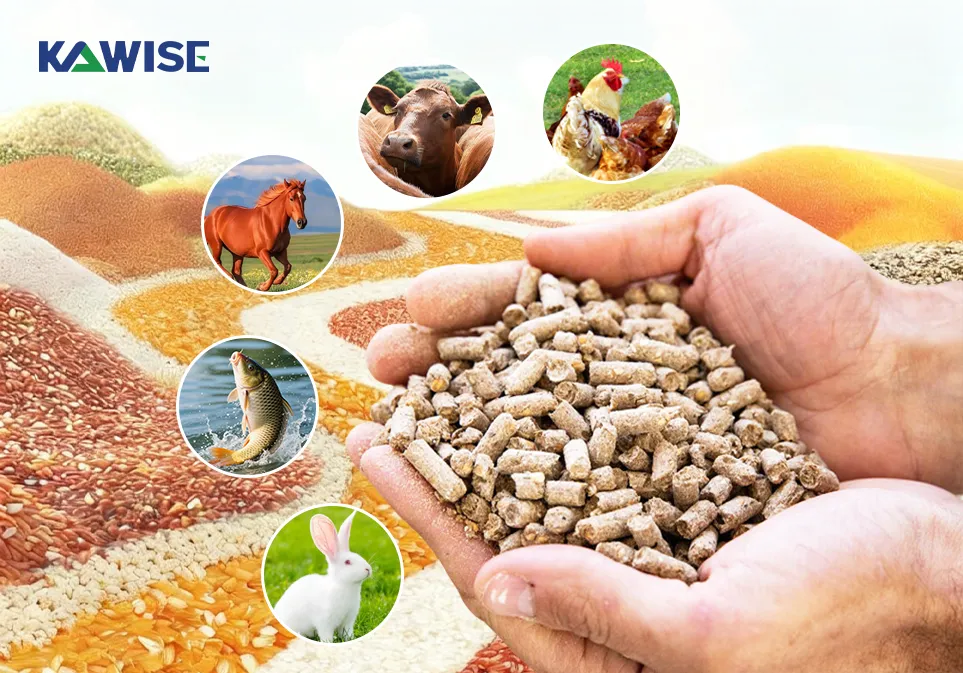
- Chicken Feed Formulation
- Duck Feed Formulation
- Goose Feed Formulation
- Cattle Feed Formulation
- Sheep Feed Formulation
- Pig Feed Formulation
- Horse Feed Formulation
- Aquatic Feed Formulation
- Rabbit Feed Formulation
Chicken Feed Formulation
Layers and broilers have different production goals and nutritional needs, so their feed formulas should be designed separately.

Broiler Feed Formulas
Starter Stage (0–3 weeks)
Formula 1: Corn 55.3%, soybean meal 38%, dicalcium phosphate 1.4%, limestone 1%, salt 0.3%, premix 1%.
Formula 2: Corn 54.2%, soybean meal 34%, rapeseed meal 5%, dicalcium phosphate 1.5%, limestone 1%, salt 0.3%, vegetable oil 3%, premix 1%.
Formula 3: Corn 55.2%, soybean meal 32%, fish meal 2%, rapeseed meal 4%, dicalcium phosphate 1.5%, limestone 1%, salt 0.3%, vegetable oil 3%, premix 1%.
Grower Stage (3–6 weeks)
Formula 1: Corn 58.2%, soybean meal 35%, dicalcium phosphate 1.4%, salt 0.3%, vegetable oil 3%, additives 1%.
Formula 2: Corn 57.2%, soybean meal 31.5%, rapeseed meal 5%, dicalcium phosphate 1.5%, limestone 1.2%, salt 0.3%, vegetable oil 2.5%, additives 1%.
Formula 3: Corn 57.7%, soybean meal 27%, fish meal 2%, rapeseed meal 4%, cottonseed meal 3%, dicalcium phosphate 1.3%, limestone 1.2%, salt 0.3%, vegetable oil 2.5%, additives 1%.
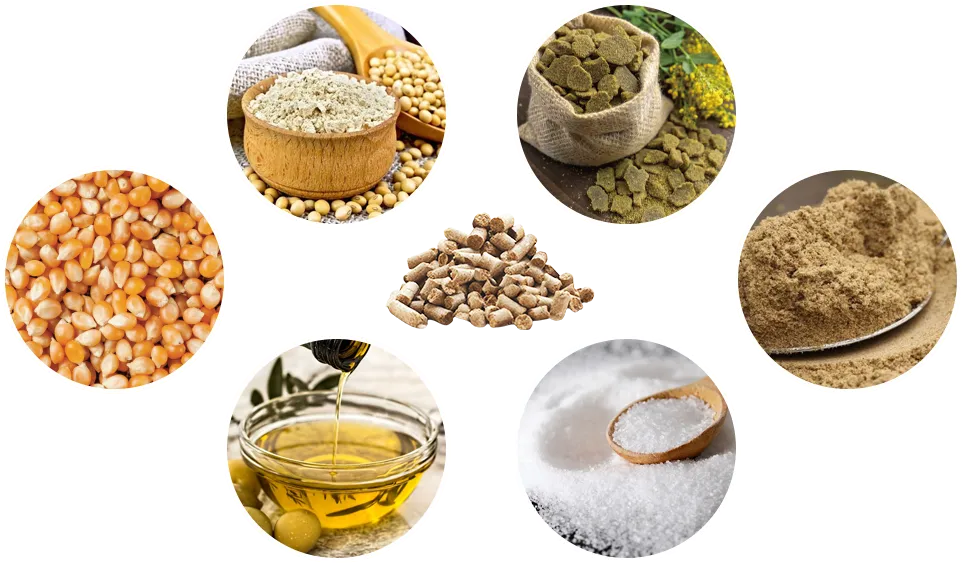
Finisher Stage (6 weeks and above)
Formula 1: Corn 60.2%, wheat bran 3%, soybean meal 30%, dicalcium phosphate 1.3%, limestone 1.2%, salt 0.3%, vegetable oil 3%, additives 1%.
Formula 2: Corn 59.2%, wheat bran 3%, soybean meal 30%, rapeseed meal 9.5%, dicalcium phosphate 1.3%, limestone 1.2%, salt 0.3%, vegetable oil 3%, additives 1%.
Formula 3: Corn 60.7%, soybean meal 21%, fish meal 2%, rapeseed meal 4.5%, cottonseed meal 5%, dicalcium phosphate 1.3%, limestone 1.2%, salt 0.3%, vegetable oil 3%, additives 1%.

Layer Feed Formulas
Layers focus on steady egg production, shell strength, and body condition rather than rapid weight gain.

Starter Stage (0–6 weeks)
Corn/wheat 55–60%, soybean meal 30–35%, fish meal or animal protein 2–4%, bran or rapeseed meal 4–6%, dicalcium phosphate 1.4–1.6%, limestone 1%, salt 0.3%, vegetable oil 0.8–1.2%, premix 1–1.3%.
Grower Stage (7–18 weeks)
Corn/wheat 57–62%, soybean meal 25–30%, bran or rapeseed meal 5–8%, fish meal 1–3%, dicalcium phosphate 1.3–1.5%, limestone 1–1.2%, salt 0.3%, vegetable oil 0.5–1%, premix 0.8–1%.
Laying Stage (19 weeks and above)
Corn/wheat 56–60%, soybean meal 22–26%, bran or rapeseed meal 4–7%, fish meal 1–3%, limestone (mix of coarse and fine) 8–10%, dicalcium phosphate 1.2–1.4%, salt 0.3%, vegetable oil 0.4–0.8%, premix 0.8–1%.

Duck Feed Formulation
Starter Stage (1–25 days)
Corn 50%, rapeseed meal 20%, broken rice 10%, wheat bran 10%, fish meal 6.5%, bone meal 1%, shell powder 1%, salt 0.5%, additives 1%.
Grower Stage (26–50 days)
Corn 50%, rapeseed meal 5%, broken rice 10%, wheat 17%, bran 11%, fish meal 4.5%, bone meal 1%, shell powder 1%, salt 0.5%, additives 1%.
Finisher Stage (51 days to market)
Corn 35%, rice bran 25%, coarse flour 26.5%, soybean meal 5%, fish meal 3%, bone meal 1%, shell powder 2%, salt 0.5%, additives 1%.
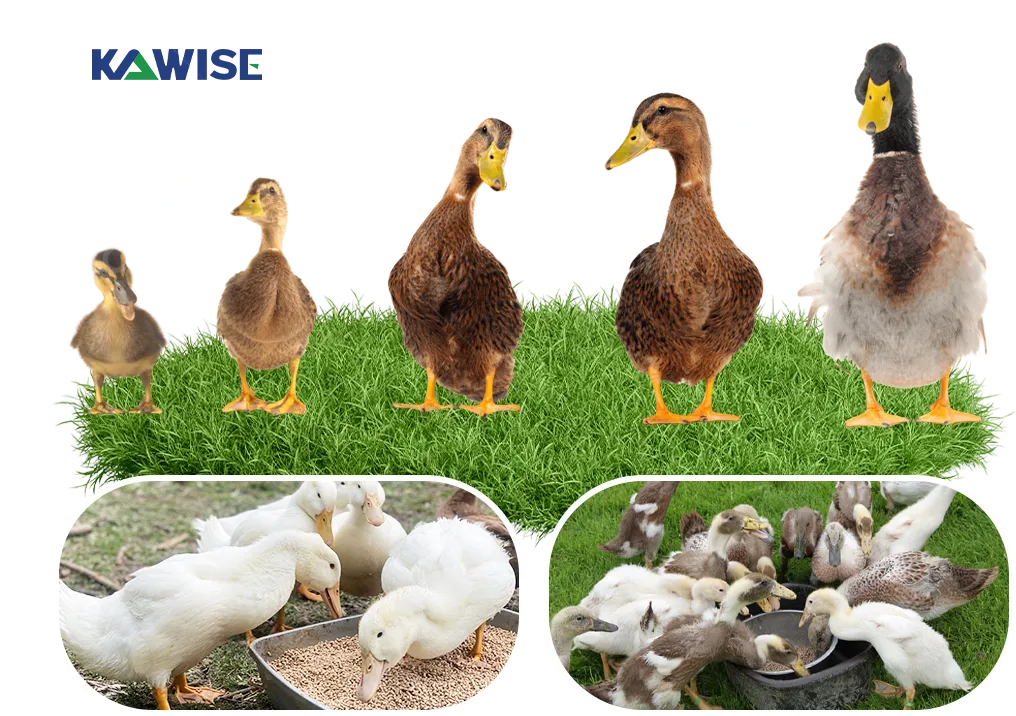
Goose Feed Formulation
Gosling Stage (1–21 days)
Corn flour 50%, fish meal 8%, soybean meal 10%, wheat bran 15%, grass meal 15%, bone meal 0.7%, salt 0.3%, growth promoter 1%.
Fresh green forage can also be offered daily.
Growing to Finishing Stage
Corn flour 35%, wheat bran 15%, grass meal 18%, silkworm pupae 15%, rapeseed meal 15%, bone meal 0.7%, salt 0.3%, growth promoter 1%.

Cattle Feed Formulation
Beef and dairy cattle have different physiological needs and production goals. Beef cattle require higher energy intake for weight gain and finishing, while dairy cows need balanced nutrition to support milk yield and quality. Therefore, their feed formulations differ accordingly.

Beef Cattle Feed Formulas
Calves (Weaning to under 100 kg)
High-quality hay or corn silage 50%, corn flour 25%, soybean meal 10%, wheat bran 8%, bone meal 1.5%, limestone or shell powder 1%, salt 0.5%, premix 1.0–1.5%, yeast or probiotic additive 0.2–0.3%.
Growing Stage (100–300 kg)
Corn silage or hay 55%, corn flour 20%, soybean meal 8%, wheat bran 10%, cottonseed meal or rapeseed meal 3%, bone meal 1%, limestone or shell powder 1%, salt 0.5%, premix 1%.
Fattening Stage (above 300 kg)
Corn silage or hay 40%, corn flour 35%, soybean meal 8%, wheat bran 10%, cottonseed meal or rapeseed meal 3%, bone meal 1%, limestone or shell powder 1%, salt 0.5%, premix 1%.

Dairy Cow Feed Formulas
Calves (Weaning to under 100 kg)
High-quality hay or corn silage 50%, corn flour 25%, soybean meal 12%, wheat bran 8%, bone meal 1.5%, limestone or shell powder 1%, salt 0.5%, premix 1.5%, yeast or probiotic additive 0.3%.
Growing Stage (100–300 kg)
Corn silage or high-quality hay 50%, corn flour 20%, soybean meal 10%, wheat bran 10%, rapeseed meal 5%, bone meal 1%, limestone 1%, salt 0.5%, premix 1%.
Lactation Stage (Adult Cows)
Corn silage or alfalfa hay 45%, corn flour 25%, soybean meal 13%, rapeseed or cottonseed meal 5%, wheat bran 5%, bone meal 1%, limestone or shell powder 1.2%, salt 0.5%, premix 1.3%, sodium bicarbonate 0.5%.
Use fresh, high-quality forages like alfalfa and corn silage. Adjust protein sources by milk yield, and add calcium, baking soda, and yeast to keep milk production stable and cows healthy.
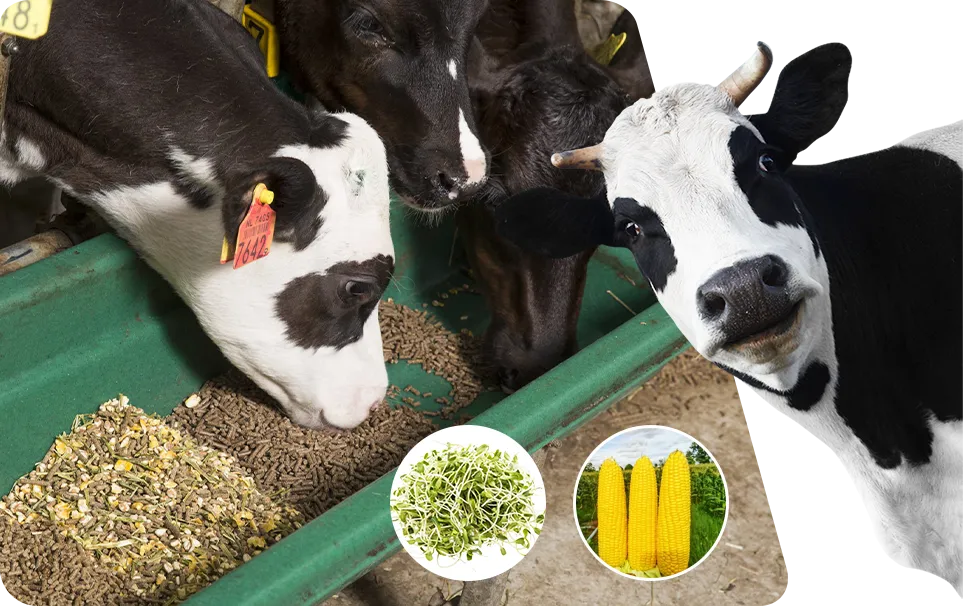
Sheep Feed Formulation
Lamb Stage (up to 20 kg)
Corn flour 40%, soybean meal 18%, fish meal 4%, wheat bran 10%, quality hay powder 20%, bone meal 1%, limestone 1%, salt 0.5%, premix 1.5%, yeast or probiotics 0.3%.
Growing Stage (20–35 kg)
Corn silage or hay 45%, corn flour 25%, soybean meal 10%, wheat bran 10%, rapeseed meal 5%, bone meal 1%, limestone 1%, salt 0.5%, premix 1.5%.
Fattening Stage (over 35 kg)
Corn silage or hay 40%, corn flour 35%, wheat bran 10%, soybean meal 8%, rapeseed meal 3%, bone meal 1%, limestone 1%, salt 0.5%, premix 1.5%.
Breeding and Lactation Ewes
Corn silage or alfalfa hay 45%, corn flour 25%, soybean meal 12%, wheat bran 8%, rapeseed meal 5%, bone meal 1%, limestone 1%, salt 0.5%, premix 2%.
Use clean, high-quality forages like corn silage or alfalfa hay. Adjust protein and mineral levels as needed to support growth, reproduction, and milk production.

Pig Feed Formulation
Suckling Piglets (7–25 kg)
Corn powder 52%, Soybean meal 18%, Fish meal 6%, Expanded soybean 5%, Whey powder 5%, Wheat bran 8%, Bone meal 1%, Limestone 1%, Salt 0.3%, Compound premix 2.0%, Probiotics or acidifiers 0.2%.
Nursery Pigs (25–45 kg)
Corn powder 60%, Soybean meal 16%, Expanded soybean 3%, Wheat bran 10%, Canola meal 4%, Bone meal 1%, Limestone 1%, Salt 0.3%, Compound premix 1.7%, Vegetable oil 0.5%, Yeast culture 0.2%.
Growing-Fattening Period (45–100 kg)
Corn powder 65%, Soybean meal 14%, Wheat bran 10%, Canola meal 4%, Bone meal 1%, Limestone 1%, Salt 0.3%, Compound premix 1.7%.
Breeding Sows and Lactating Sows
Corn powder 55%, Soybean meal 18%, Wheat bran 12%, Canola meal 5%, Bone meal 1%, Limestone 1%, Salt 0.3%, Compound premix 2.0%, Vegetable oil 0.7%, Yeast additive 0.2%.
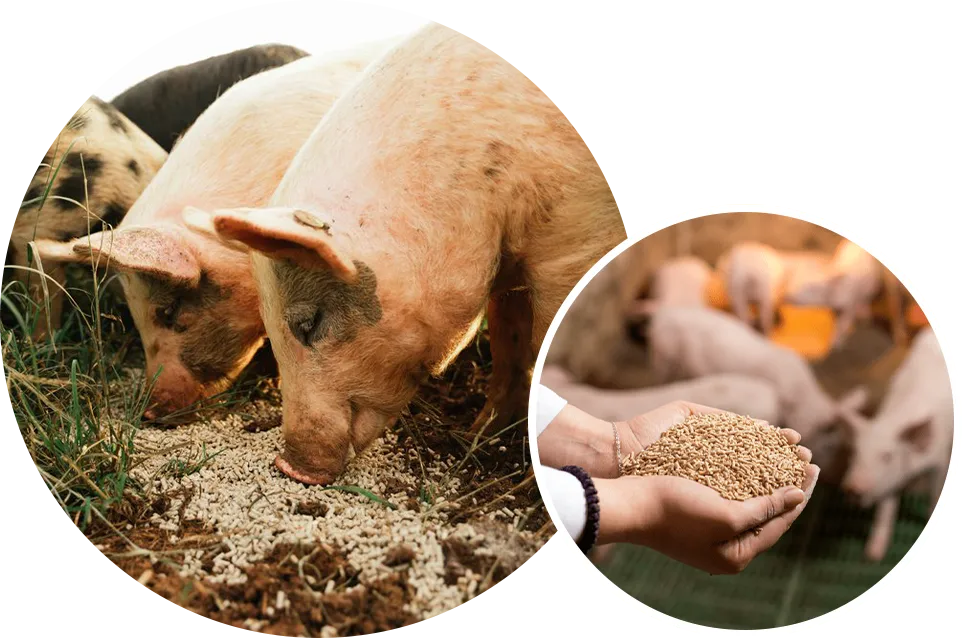
Horse Feed Formulation
Foals (under 6 months)
Hay (alfalfa or pasture) 60%, corn flour 15%, soybean meal 10%, wheat bran 10%, mineral premix 5%, vegetable oil as needed.
Adult Horses (maintenance or light work)
Hay (pasture or alfalfa) 70%, corn flour 20%, wheat bran 5%, mineral premix 2%, vegetable oil as needed.
Performance Horses (intensive work)
Hay (pasture or alfalfa) 50%, corn flour 30%, soybean meal 10%, wheat bran 5%, mineral premix 5%, vegetable oil as needed.
Pregnant or Lactating Mares
Hay (pasture or alfalfa) 65%, corn flour 20%, soybean meal 10%, wheat bran 5%, mineral premix 5%, vegetable oil as needed.

Aquatic Feed Formulation
Carp Feed
Formula 1: Wheat bran 43%, fish meal 30%, soybean cake 15%, barley 10%, additives 2%, vegetable oil 2–3%.
Formula 2: Corn flour 25%, wheat flour/bran 25% (with wheat ≥10% as a binder), soybean meal 22%, rapeseed meal 10%, fish meal 12%, vegetable oil 3%, dicalcium phosphate 1.5%, vitamin-mineral mix 1.5%.
Grass Carp Feed
Formula 1: Corn flour 30%, wheat flour/bran 30%, soybean meal 20%, rapeseed meal 12%, vegetable oil 2%, vitamin-mineral mix 2%, dicalcium phosphate 1%, enzyme or prebiotic 1%.
Formula 2: Wheat flour 28%, corn flour 25%, soybean meal 28%, rapeseed meal 12%, soybean oil 3%, vitamin-mineral mix 2%, dicalcium phosphate 1%, lysine 0.5% (can be included in the premix).
Tilapia Feed
Wheat flour 22%, corn flour 20%, soybean meal 32%, DDGS 12%, fish meal 6% (can be replaced with fermented rapeseed meal or insect protein), vegetable oil 4%, vitamin-mineral mix 2%, dicalcium phosphate 2%.
Black Carp Feed
Formula 1: Wheat flour 20%, corn flour 18%, soybean meal 22%, fish meal 20%, meat or shell powder 10%, vegetable oil 4%, vitamin-mineral mix 3%, dicalcium phosphate 3%.
Formula 2: Wheat flour 22%, corn flour 25%, soybean meal 20%, fish meal 15%, meat or shell powder 10%, vegetable oil 4%, vitamin-mineral mix 2%, dicalcium phosphate 2%.
Black carp mainly feed on snails and shells. Replacing part of the fish meal with snail or clam powder improves palatability and calcium-to-phosphorus balance.
Shrimp Feed
Fish meal 30%, soybean meal 15%, corn flour 25%, wheat flour 10%, rapeseed meal 10%, wheat bran 5%, vegetable oil 5%, dicalcium phosphate 1.5%, calcium powder 2%, vitamin premix 2%, yeast supplement 1%.

Fish feed can be either floating or sinking, depending on the species and farming method. Choosing the right type helps improve feed conversion and keep fish healthy.
Rabbit Feed Formulation
Young Rabbits (birth to 6 weeks)
Fish meal 20%, soybean meal 15%, alfalfa hay 30%, wheat bran 10%, rice bran 10%, vegetable oil 2%, calcium powder 1.5%, vitamin premix 1.5%, probiotics or yeast 1%.
Growing Rabbits (6 weeks to 6 months)
Soybean meal 25%, corn flour 20%, wheat bran 15%, rapeseed meal 12%, fish meal 10%, rice bran 10%, vegetable oil 4%, mineral mix 2%, yeast supplement 1%.
Adult Rabbits (over 6 months)
Timothy hay 50%, wheat bran 25%, corn flour 10%, soybean meal 8%, vegetable oil 2%, vitamin-mineral mix 2%, calcium powder 1%.
Pregnant or Lactating Does
Soybean meal 30%, fish meal 15%, corn flour 15%, wheat bran 10%, rapeseed meal 10%, alfalfa hay 10%, bone meal 3%, vegetable oil 4%, vitamin-mineral mix 3%, vitamin E 1%.
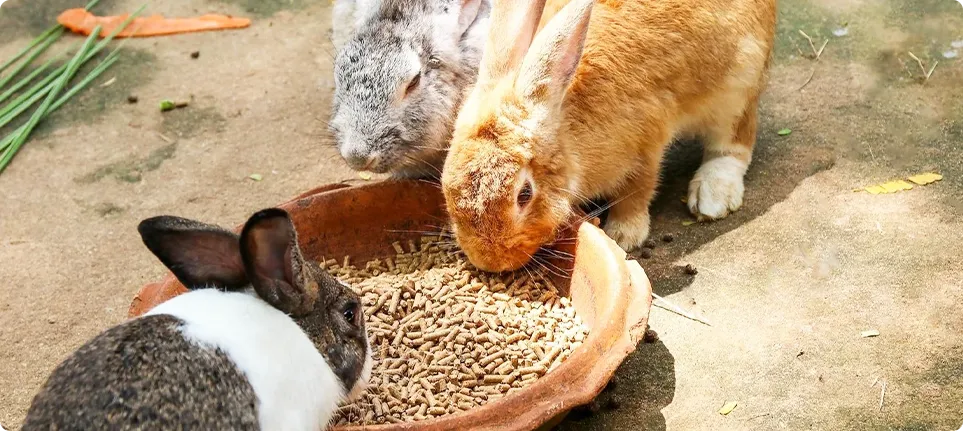
If you'd like to learn more about how to make rabbit feed, check out our blog. It explains the full process and key tips to help you make quality pellets easily.
Feed formulas can be adjusted based on local ingredient costs and supply. The above data come from user experience and are for reference only.
Choosing the right pellet machine is key to making quality feed. We offer various models and production lines to help you work efficiently. Contact us for details.
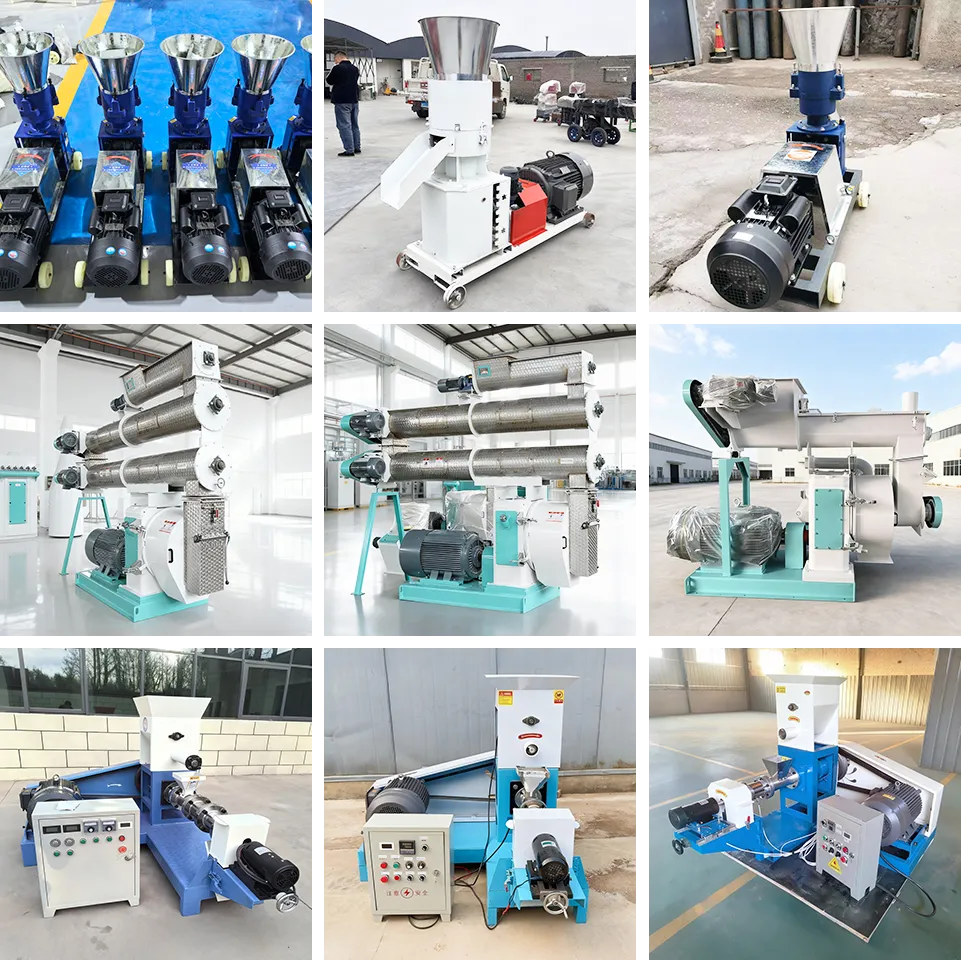

 Online Contact
Online Contact Send Message
Send Message
Need Some Help?
Contact us quickly and we will reply you within 24 hours. We will not disclose your information.